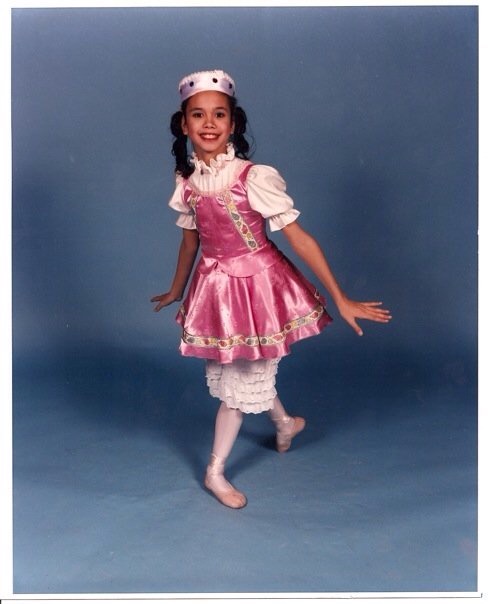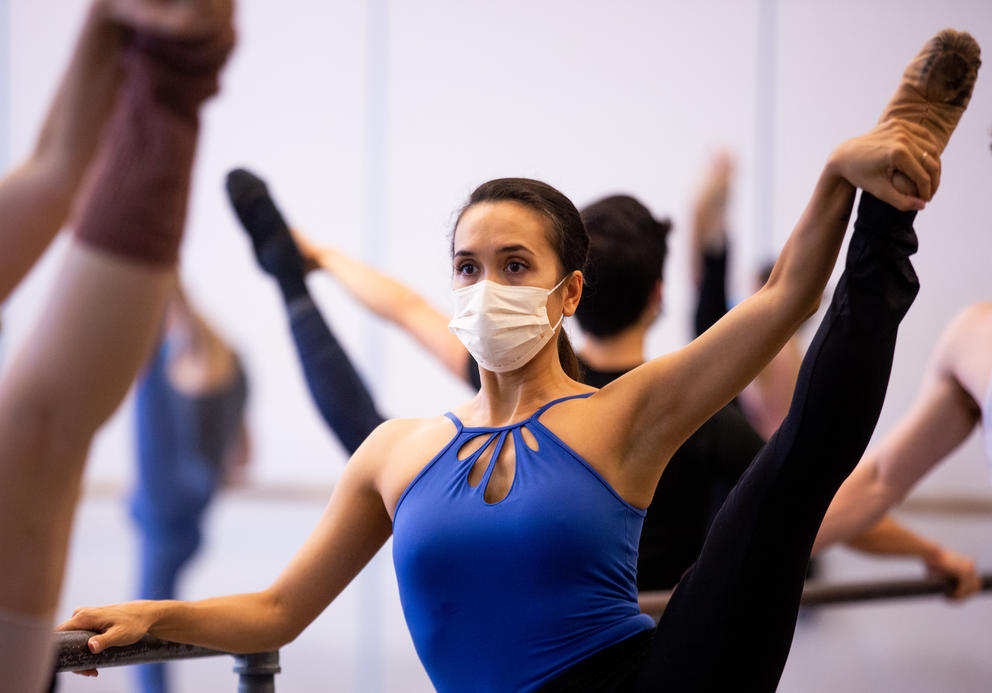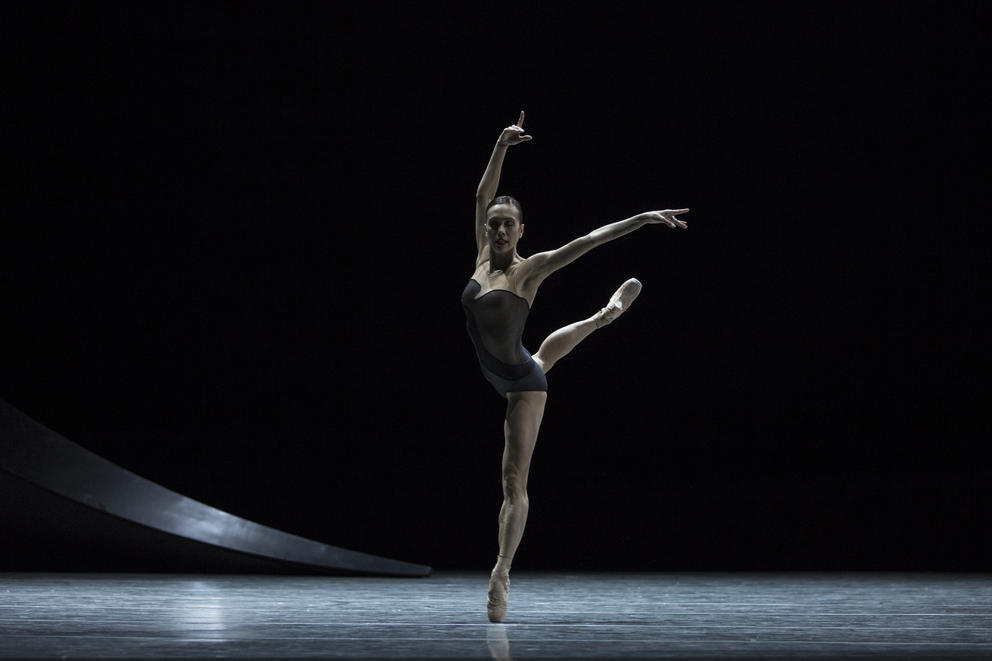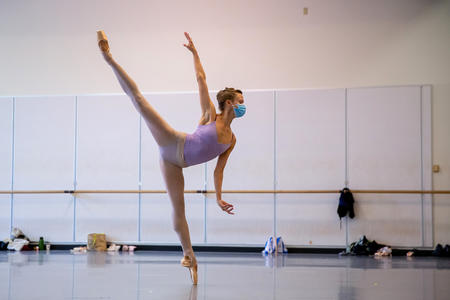Pantastico was caught off guard by the deluge of messages of gratitude and well wishes she received.
“I wasn’t aware how well people thought of me,” she says, with no false modesty.
Pantastico is a fan favorite at PNB, where the Hawai‘i native spent most of her 25-year career. In the news release announcing her departure, Artistic Director Peter Boal noted Pantastico’s “singular ability to connect with audiences.” She’s danced hundreds of roles over the years — from a fairy queen to an agonized swan — but Boal cited her performance as Juliet in choreographer Jean-Christophe Maillot’s Roméo et Juliette as “perhaps the most defining” of Pantastico’s long career.
In that role, Pantastico fully embodies the persona of a young teenager in the throes of first love. When she spies Romeo from her balcony, her dark, expressive eyes and wide smile convey a palpable joy. She glides toward him shyly, only to dart away from a first kiss. Their arms entwine, then snake upward together, like dolphins breaking the sea’s surface for air. When the couple sinks to the stage, Pantastico drapes supine over Roméo’s legs. She arches her back upwards, and her face rises to meet his, a tender consummation of their love.
Fittingly, the ballerina will bid her fans goodbye after one last go-round in the role — in which Juliet famously dies.
“There’s something poetic about exiting the stage this way,” Pantastico says, laughing, “kind of killing myself off.”
She first danced Juliet in the 2008 PNB debut of Maillot’s version of the legendary ballet (which he created in 1996). After a colleague was injured, Pantastico appeared in nine consecutive performances, dancing five of them with the up-and-coming lead, Lucien Postlewaite, who developed into another popular PNB principal dancer.
The two sparked from their first encounter at the Capulet’s ball. When Postlewaite spied Pantastico’s Juliet, wrapped in a filmy swath of golden fabric, it felt as if all action around them came to a dead stop. His lovestruck Roméo wasn’t just a stage pretense.
“I don’t think people remember the early years,” Postlewaite says, “when she was like a star, and I was just so enamored of her. I have a total work crush on Noe, and I have since the beginning.”
Pantastico’s 2008 performances wowed critics, audiences and choreographer Maillot, who invited her to join his company, Les Ballets de Monte-Carlo. She left Seattle for Monaco that same year. In 2012, Postlewaite joined her there. They toured the world together, developing a special onstage partnership.
“Having spent so much time with her, we kind of speak the same language,” says Postlewaite. “That sort of trust, synchronicity, means we can dance even more fully, more in tune with each other.”
These two stars reunited at PNB in 2017 and have continued to dazzle audiences, most recently last September in PNB choreographer-in-residence Alejandro Cerrudo’s Silent Ghost. In that piece, their duet demonstrated the physical language dancers speak to one another — two bodies in continual conversation as they move around, under and atop — as Pantastico balanced on Postlewaite’s back, unfurling her limbs like a starfish.
Pantastico, who will turn 42 in May, joined PNB as an apprentice in 1997. Since returning to PNB in 2015, she has danced in everything from the classic Swan Lake to contemporary ballets by Cerrudo, Crystal Pite and David Dawson. Her performances are as exquisite as ever, but Pantastico says moving between classical and modern works demands different things from her body — demands that have taken their toll.
“I’ve always suffered wear-and-tear injuries, but this year it was a little harder to manage,” Pantastico admits. “There’s a part of me that, deep down, knew, ‘OK, you have to start thinking seriously about retirement.’ ”
Once she made that decision, and began talking to people about jobs, Pantastico was offered a faculty position at the prestigious Central Pennsylvania Youth Ballet, where she (and many other professional dancers) trained from the late 1980s until she joined PNB in 1997.
Although she has taught ballet in the past, Pantastico knows it will take time to retune her classroom skills. Beyond ballet technique, she’s eager to impart to young dancers everything she has learned about the profession, from coping with the intense daily physical grind to how to stand up for yourself in a ballet company’s highly competitive atmosphere.

“We dancers have a lot more power than we think,” Pantastico says, something she has learned over the years. To her mind, young dancers are savvier now than when she was starting out. In the wake of George Floyd’s 2020 murder by Minneapolis police, she watched her PNB colleagues advocate for — and achieve — concrete progress toward racial representation at the ballet company, onstage and off. They’ve welcomed younger, more diverse choreographers as well.
But Pantastico admits ballet still has to address the fact that some of the art form’s older ballets — works she still loves — remain problematic for 21st century audiences, replete with inherent racism, sexism and unrelatable story lines.
“There has to be a way to maintain ballet’s legacy, but build on top of it, create something more well-rounded and supportive,” she says.
Which brings Pantastico back to her experience at Les Ballets de Monte-Carlo, where Artistic Director Maillot has reenvisioned several classic ballets; in addition to Roméo et Juliette, his repertoire includes new versions of Cinderella, Sleeping Beauty and Swan Lake. The stories are unchanged, but the abstract sets and fanciful costumes feel fresh and modern, untethered to specific eras or places.
Beyond the design elements, the plot unfolds differently from a traditional ballet. In Roméo et Juliette, for example, Maillot tells the story without pauses for audience applause after bravura solos, almost like a stage play or film, which heightens the drama. Pantastico believes European companies like Maillot’s have pushed ballet further than their American counterparts, but she’s optimistic that young artists in this country can do the same thing.
To that end, four years ago she and PNB colleague James Yoichi Moore founded Seattle Dance Collective, commissioning new work from an array of contemporary choreographers. Although Pantastico is leaving Seattle, Moore says their Seattle Dance Collective work together will continue.
In the meantime, when the curtain goes up on PNB’s latest production of Roméo et Juliette (at McCaw Hall Feb. 4-13; streaming digitally Feb. 24-28), Moore will be Pantastico’s Roméo in four of the shows, and he couldn’t be happier.
The two last performed these roles together in 2016, with an earthy onstage chemistry that Moore believes originated in Pantastico’s commitment to her character.
“It’s like an aura that exudes out of her,” Moore explains, something that he felt freed him up to dance a lusty Roméo, sharing what looked like steamy kisses with his Juliet.
“When I was a little kid, thinking about my career, dancing with Noe is what I dreamed it would be. It’s just the pinnacle, dancing with her,” says Moore.
Christopher D’Ariano echoes that sentiment. The young corps de ballet member made his debut as the Cavalier to Pantastico’s Sugar Plum Fairy in PNB’s most recent Nutcracker production.
“Dancing with Noe was nothing short of magic,” he says. “She taught me to believe; she paved the way for so many of us with her gracious energy.”
Boal, the PNB artistic director, has often remarked on Pantastico’s offstage generosity, her role as an unofficial mentor to up-and-coming dancers like D’Ariano. That quality will be invaluable once the ballerina becomes a teacher. But Pantastico has a few more performances to give before that transition, including one last dance with longtime partner Postlewaite (the two will be paired in the roles on Feb. 10), an experience he thinks will be bittersweet.
“We’ve danced this ballet in London, Rio de Janiero, Beijing and Seattle. I’m going to hold on to those memories because they’re so beautiful,” he says.
Pantastico cherishes the memories, too, but for the last production of her professional dancing career, she plans to savor her final hours with a rapt audience. Her last dance will be on Feb. 13, a Sunday afternoon.
“When I step out on that balcony and look out, I’m with everyone,” Pantastico says. “I want that experience to go out on.”
Get the latest in local arts and culture
This weekly newsletter brings arts news and cultural events straight to your inbox.









